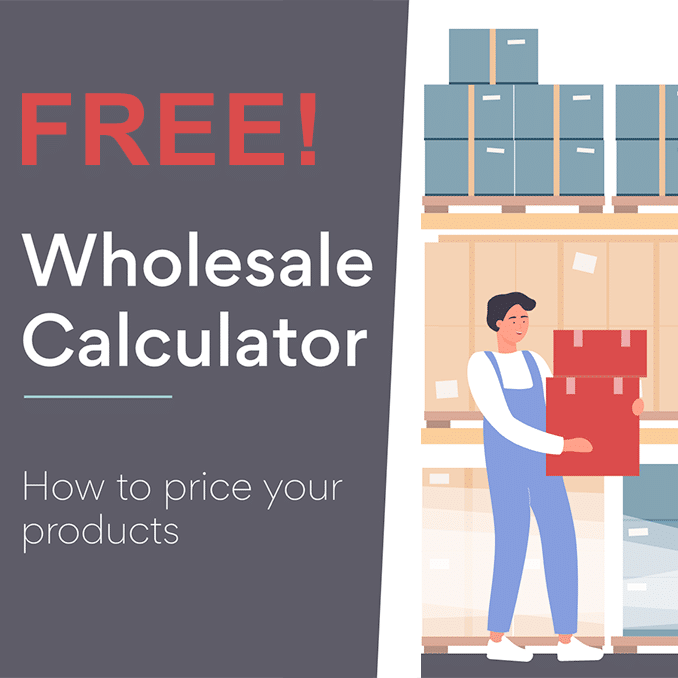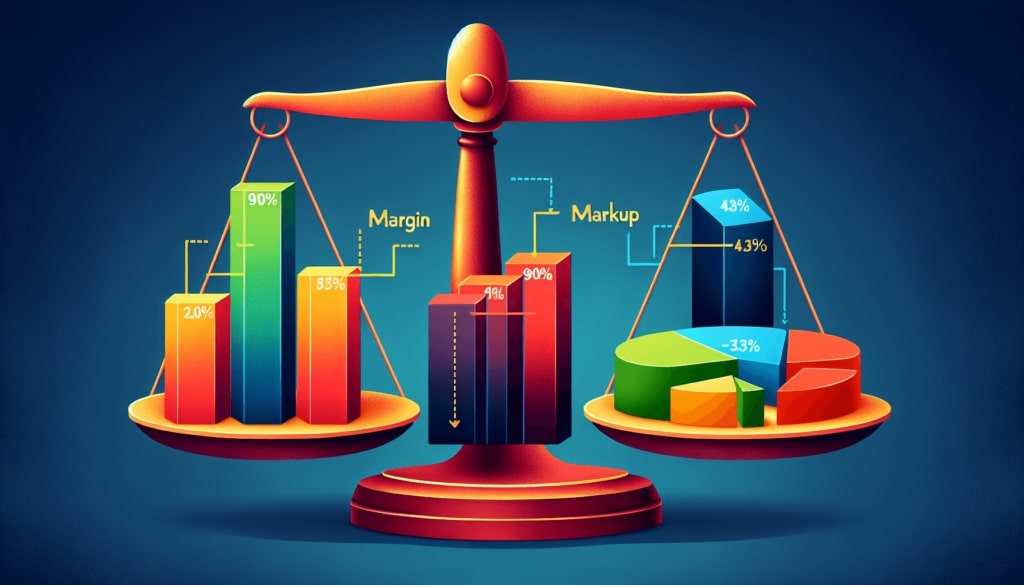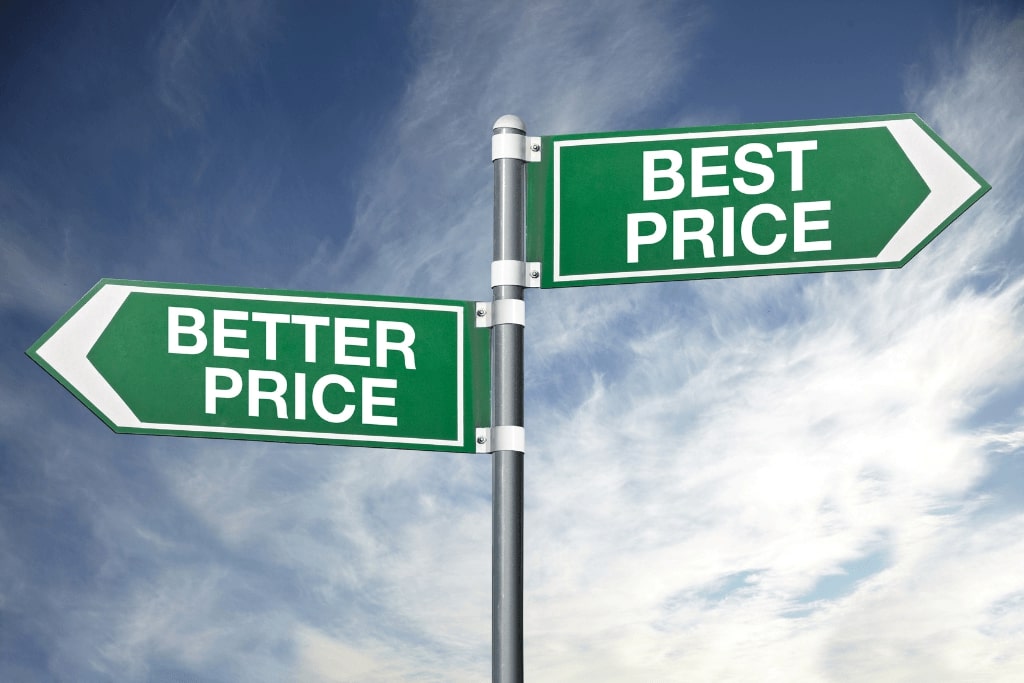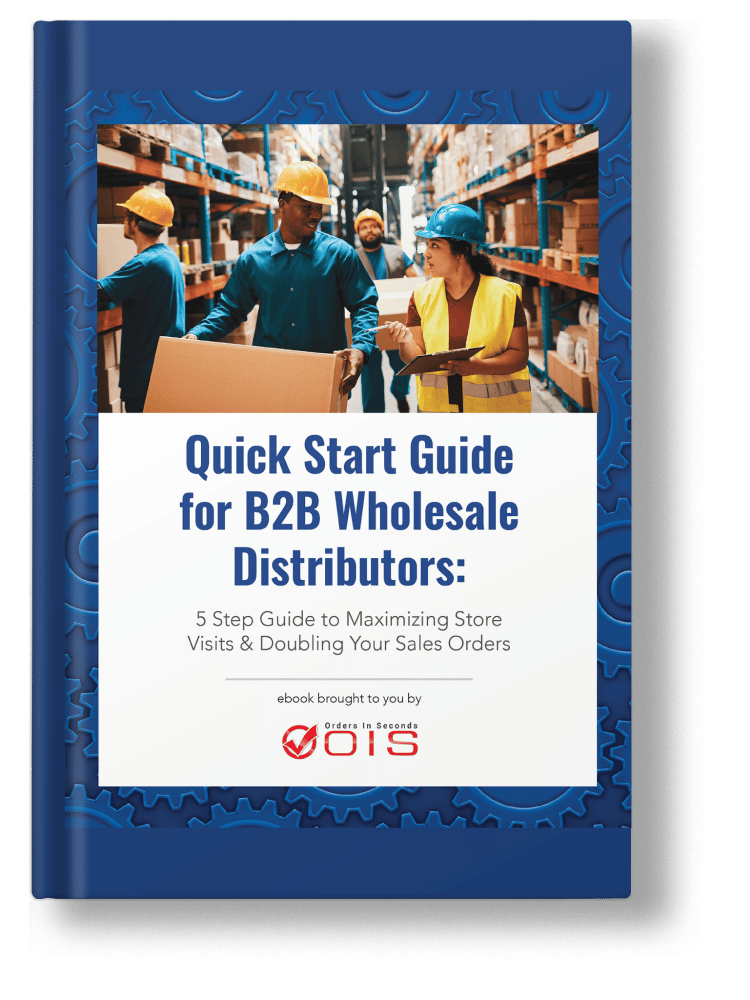Key Takeaways
- Margin and markup are not the same — Margin measures your profit as a percentage of the selling price, while markup calculates how much more you're charging over the cost.
- Using the wrong formula can cost you — Confusing margin with markup can lead to underpricing your products or overstating your profits.
- Smart pricing starts with the right tools — Knowing how to calculate margin and markup accurately is key to building a pricing strategy that drives revenue and keeps your business competitive.
What’s the Difference Between Margin and Markup?

Margin and markup are both pricing formulas—but they’re not the same. Margin (also called gross profit margin) measures how much profit you’re keeping on a sale, while markup is how much you’re increasing cost to set the sale price.
Knowing the difference is crucial for pricing your products correctly, protecting your profit, and avoiding costly errors in your business.
Why It Matters for Your Business
If you’re running a wholesale distribution business, setting prices based on incorrect margins or overestimated markups can lead to undercharging (and lost profits) or overpricing (and lost sales).
Let’s break it down simply.
Formula for Calculating Margin
Margin (%) = (Selling Price – Cost) ÷ Selling Price × 100
Example:
-
Selling Price: $100
-
Cost: $60
-
Margin = (100 – 60) ÷ 100 = 40%
This means you’re keeping 40% of the sale as profit.
Formula for Calculating Markup
Markup (%) = (Selling Price – Cost) ÷ Cost × 100
Example:
-
Cost: $60
-
Markup = (100 – 60) ÷ 60 = 66.7%
You’re charging 66.7% more than the cost.
Why People Confuse Margin and Markup
Because both involve cost and price, people often assume they’re interchangeable. But if you use markup when you mean margin, your profit numbers can be way off.
🔥 Pro Tip: A 50% markup ≠ 50% margin.
In fact, a 50% markup is only a 33% margin.
Use the Right Formula for the Right Goal
| Goal | Use Margin | Use Markup |
|---|---|---|
| Measuring profitability | ||
| Setting retail price | ||
| Analyzing business health | ||
| Analyzing business health |
Free Tools to Calculate Margin vs. Markup
Use our free profit margin calculator to quickly determine the right prices for your wholesale business.

FREE Wholesale Pricing Calculator
Determining the best pricing is tough work for even the most experienced distributor. With our free calculator, you can calculate wholesale prices for products and much more.
Download your free wholesale pricing calculator now to get started.
Common Pricing Mistakes to Avoid
- Setting prices based on "gut feeling"
- Using markup when your business model relies on margin
- Ignoring hidden costs like shipping or handling
- Not adjusting pricing based on industry trends

Learn More About Pricing Strategy
Here are some additional resources to level up your pricing game:
Calculating Markup: A Comprehensive Guide

Venturing into the realm of markup, let’s navigate its calculations. Unlike fixed stars in the sky, markup percentages are unique to each business, determined based on several factors. These include the type of industry, the pricing strategies of competitors, and the nature of the products or services offered.
To increase the markup percentage, a business can either raise the price at which a product is sold or cut down the costs associated with providing that product or service. Choosing the appropriate markup percentage is crucial as it guarantees the business’s profitability and competitiveness within its market.
Markup Calculation
The markup formula is used to calculate markup, which is the difference between the selling price and the cost of the item. It helps to determine the increase in price when selling items. The markup percentage is calculated by dividing the gross profit of an item by its cost, and multiplying by 100 to express it as a percentage.
To calculate the markup percentage, you can use the following formula:
Markup Percentage = (Selling Price – Cost Price) / Cost Price * 100
Determining the Right Markup Percentage
The winds of markup may vary in strength, but determining the right markup percentage ensures a smooth sail. Factors that influence markup percentages include the type of industry, the pricing strategies of competitors, and the nature of the products or services offered.
For example, restaurants typically set high initial markups ranging from 200% to 400% over wholesale costs to cover overhead such as labor and service. Meanwhile, in highly competitive markets, businesses tend to use lower markups, often ranging between 1% and 3% per item. Thus, determining the right markup percentage is crucial for setting competitive prices and maximizing profitability.
IMU vs Margin
Initial Markup (IMU) and Margin are both key metrics in pricing strategy, but they differ in application. IMU refers to the percentage difference between the cost of a product and its initial selling price, reflecting the planned profit before any discounts or adjustments. Margin, on the other hand, is the percentage of the final selling price that remains after covering the cost of goods sold (COGS). While IMU helps in setting initial pricing, margin reveals the actual profitability after sales transactions. Understanding both allows businesses to gauge their pricing effectiveness and profitability over time.
Calculate Margin vs Markup: When to Use Each

Margin vs Markup Explained
Margin and markup are closely related but serve different purposes in financial analysis. Markup refers to the percentage added to the cost price of goods to arrive at the selling price. For example, a 50% markup on a $100 product results in a $150 selling price. Margin, on the other hand, is the percentage of the selling price that represents the profit after accounting for the cost. Using the same $150 selling price, the margin would be 33%, since $50 (the profit) is 33% of $150. While both terms are used in pricing, it’s essential to know the difference for accurate profit analysis.
While steering through the financial waters of business profitability, decisions often pivot between margin and markup. Each is a crucial metric in its own right. Margin is the best choice for calculating a company’s profits, making it critical for profit analysis. On the other hand, markup is invaluable for setting initial prices and should be used when a business aims to achieve a certain profit level from the sale of its products or services.
For maximum profitability, it is imperative to calculate both margin and markup. This dual approach provides a complete picture of business performance and ensures that product pricing is adequate. It’s like using both a compass and the winds to navigate a ship – both are necessary for a successful voyage.
Using Margin for Profit Analysis
When it comes to profit analysis, margin stands as a sturdy compass, guiding businesses towards profitability. It’s a crucial metric for analyzing the financial health of a company, its management’s effectiveness, and its growth potential.
A healthy profit margin indicates efficient conversion of income into profit and is essential for a company’s long-term sustainability. Gross margin, in particular, highlights a company’s financial health by measuring production and business efficiencies, aiding in pricing strategies, and assessing competitive positioning.
Thus, using margin for profit analysis can steer businesses towards profitability and growth.
Desired Profit Margin
The desired profit margin is the percentage of the selling price that remains after all costs have been deducted, representing the profit the business aims to achieve. This margin varies depending on the industry, market conditions, and individual business goals. For instance, a company might set a desired profit margin of 40%, meaning that after covering all costs, 40% of the revenue from each sale should contribute to profit. Calculating and setting a desired profit margin helps companies make strategic pricing decisions that align with their financial goals, ensuring long-term sustainability and growth.
Using Markup for Pricing Decisions
As the wind in your sails, markup propels your pricing strategy forward. It’s valuable for setting initial prices and ensuring revenue on each sale. High initial markups, such as those set by restaurants and luxury goods providers, can cover overhead costs and target markets with lower price sensitivity. On the other hand, lower markups are often used in highly competitive markets where there are many substitutes.
Different industries adopt various standard markup percentages; some industries go as low as 5%-10%, while others may apply significantly higher markups to their products. Thus, using markup for pricing decisions can set your business on a profitable course, balancing competitive pricing with adequate revenue generation.

In the journey of business profitability, the capability to interchange between margin and markup proves vital. This skill allows us to have an accurate understanding of our financial reporting and pricing strategies. It’s important to note that markups are always higher than their corresponding margins due to their predictable relationship.
This conversion process involves a series of calculations, including how to calculate margin. To determine markup percentage from a given margin, follow these steps:
Convert the margin percentage to a decimal.
Subtract the decimal from 1.
Divide 1 by this result.
Subtract 1 from this quotient.
Multiply by 100.
Conversely, a markup percentage of 25% will yield a 20% margin, demonstrating the inverse calculation from markup to margin.
Margin to Markup Conversion
As we set sail from margin to markup, we find a clear process guiding our journey. To calculate the corresponding markup percentage from a given margin, subtract the margin (expressed as a decimal) from 1 and take the inverse of this result.
For example, if the desired margin is 30%, the conversion process would result in a markup of approximately 54%. This method allows businesses to accurately set their pricing strategies, ensuring they maintain profitability while remaining competitive in the marketplace.
Markup to Margin Conversion
Charting a course from markup to margin, we encounter another set of calculations, known as markup formulas. To convert markup percentages into margin percentages, you can use the markup percentage calculation method: divide the markup percentage by the sum of 100% plus the markup percentage, then multiply by 100 to find the margin percentage.
For instance, a markup of 60% corresponds to a margin of 37.5% when using the margin formula for conversion. Thus, understanding how to convert between markup and margin ensures accurate financial reporting and effective pricing strategies.
Markup vs Margin Chart
A Markup vs Margin Chart is a valuable tool for businesses to understand the relationship between markup percentages and their corresponding profit margins. Since markup and margin are calculated differently, a chart helps visualize how a small change in markup percentage can significantly impact the margin. For example, a 50% markup might only yield a 33% margin, depending on costs and pricing. Such charts provide a quick reference for decision-makers in setting prices that balance competitive offerings with profitability.
Tips for Maximizing Profitability with Margin and Markup
After traversing the realm of margin and markup, let’s explore how to optimize profitability using these two key metrics. This involves establishing best practices for handling margins and markups, including training and education, periodic review and adjustments, and automation and software solutions.
Sales teams, in particular, must be trained on the concepts of margin and markup to understand their distinctions, how to apply them in pricing, and the limits of markups in price quotations which directly affects profitability. Additionally, regular reviews of sales transactions by internal auditing or bookkeeping departments are imperative to identify and resolve any issues with markups and margins swiftly, thereby maintaining profit margins.
Ready to turn those margins into mega-sales? Download our free eBook to discover 5 data-driven steps to double your sales orders in no time.

Double Your Sales Orders in 5 Steps
This exclusive eBook is packed with real-world, data-driven concepts that can help maximize your store visits and double your sales. Get it for FREE – Today!
Profit Margin Calculator
A Profit Margin Calculator simplifies the process of determining how much profit your business is making from its sales. By entering the cost of goods sold (COGS) and the revenue generated from the sales, the calculator will compute your gross profit margin. This tool helps businesses quickly gauge their profitability on specific products or overall sales, making it easier to adjust pricing strategies, optimize operations, or assess the need for cost reductions to improve profitability.
Training and Education
When it comes to training and education, understanding margin and markup are essential for accurate financial reporting and establishing competitive pricing. Sales teams, especially, should be well-versed in these concepts as markup is a valuable tool for salespeople who need to provide price quotes.
Training programs often include modules on how to interpret, calculate, and evaluate margin and markup for various business applications. This emphasizes their practical use in pricing and profitability analysis.
For those without prior knowledge in finance, online courses cover the theory as well as the practical calculations for markup on cost and gross profit margin.
Periodic Review and Adjustments
With the financial landscape constantly evolving, regular reviews and modifications of margin and markup strategies are vital to uphold competitiveness and maximize profitability. These reviews should reflect changes in costs, market demand, and overall business strategy to achieve sustained profitability.
Regularly evaluating and adjusting pricing strategies to align with industry averages and market trends can help maintain competitive and profitable pricing. For instance, applying a higher markup can lead to greater profit margins, though it may potentially reduce sales if customers find the prices too high.
FMCG B2B Wholesale
Automation and Software Solutions
In the current digital era, automation and software solutions can heighten the precision and efficiency of margin and markup calculations, facilitating improved pricing decisions and profit analysis. Accounting software with a built-in markup calculator can simplify the process of setting prices and contribute to better profit margin management.
Moreover, automating back-office procedures ensures timely and accurate data collection on transactions to assess:
- sales
- prices
- markups
- profit margins
Thus, leveraging technology can be a great aid in navigating the complex seas of margin and markup.
Gross Margin Percentage
Gross margin percentage is another way to express profitability. It’s calculated as (Profit / Revenue) * 100. While it’s similar to margin, it’s based on the total revenue rather than the selling price of a specific item.
Example:
Cost Price of a product: $50
Selling Price: $75
Markup: (75 – 50) / 50 * 100 = 50%
Margin: (75 – 50) / 75 * 100 = 33.33%
In summary:
- Margin is the profit expressed as a percentage of the selling price.
- Markup is the percentage increase added to the cost price.
- Mark on and markup are synonymous terms.
- Gross margin is the profit expressed as a percentage of the total revenue.
Understanding the difference between margin and markup is essential for businesses to set prices that cover their costs and generate profits.
Final Thoughts
When you understand the difference between margin vs. markup, you gain control over your pricing—and ultimately, your profits. Whether you’re running a field sales operation or managing a product catalog as a distributor, using the right calculation can mean the difference between profit and loss.
Frequently Asked Questions
-
1. How to Calculate Profit Margins?
Profit margin is a key metric that shows how much of your revenue is actual profit after covering the cost of goods sold (COGS). It helps you measure business performance, set better prices, and understand whether your company is financially healthy.
To calculate profit margins, businesses subtract the cost of goods sold (COGS) from total revenue to determine gross profit. This gross profit is then divided by total revenue to yield the gross profit margin. For example, if a product sells for $200 and costs $120 to produce, the gross profit is $80, resulting in a 40% profit margin. Understanding how to calculate profit margins is essential for assessing the financial health of a business, as it directly reflects profitability.2. What markup is 20% margin?
A 20% margin corresponds to a 25% markup. Therefore, a 25% markup is needed for a 20% margin.
3. How do you calculate a 30% margin?
To calculate a 30% margin, first convert 30% to a decimal (0.3), subtract it from 1 to get 0.7, and then divide the cost by 0.7 to find the selling price.
4. What is the difference between 30% margin and 30% markup?
The main difference between a 30% margin and a 30% markup is that the margin percentage is calculated based on the selling price minus the cost of goods sold, while the markup percentage is based on the difference between the selling price and the cost price of the product. In practical terms, for a product with a cost of $100, a 30% margin would require selling it at around $143, while a 30% markup would result in a selling price of $130.
5. How do you calculate margin and markup?
To calculate margin and markup, use the formula Gross Profit Margin = Sales Price – Unit Cost and Markup Percentage = Gross Profit Margin/Unit Cost. For example, if a product costs $100 and has a 25% markup, the selling price would be $125.
6. What influences markup percentages?
Markup percentages are influenced by factors such as the industry type, pricing strategies of competitors, and the nature of products or services offered. These factors play a crucial role in determining the markup percentage.
Mastered Margin and Markup? Now Put Your Knowledge into Action with Orders in Seconds
Orders in Seconds’ OIS Pro App empowers your field sales reps on the go. This mobile app goes beyond calculations, transforming pricing strategies into actionable tactics. From setting custom pricing and promotions for individual clients to leveraging data-driven suggestions for higher-value orders, OIS Pro App streamlines workflows and eliminates errors. It equips your team to maximize profit potential on every sale, no matter their location.
Schedule a FREE demo today to get started!






